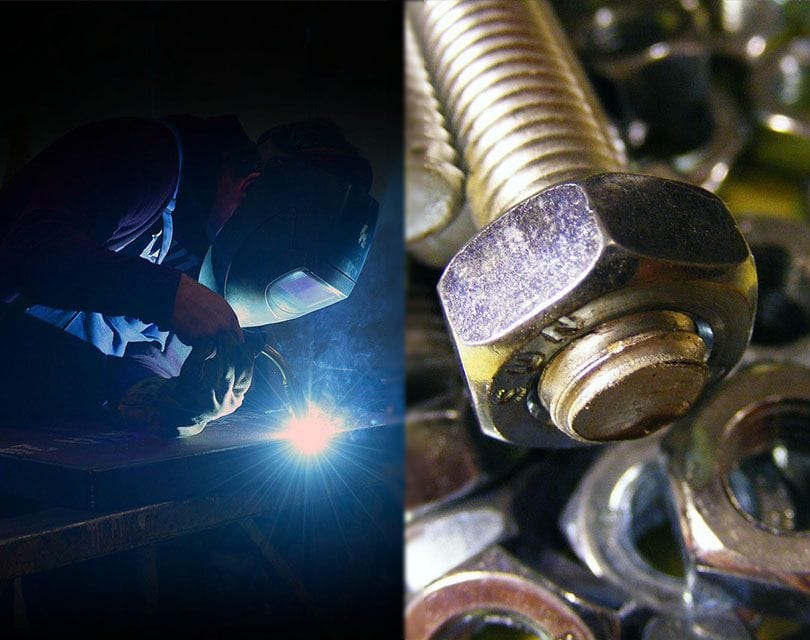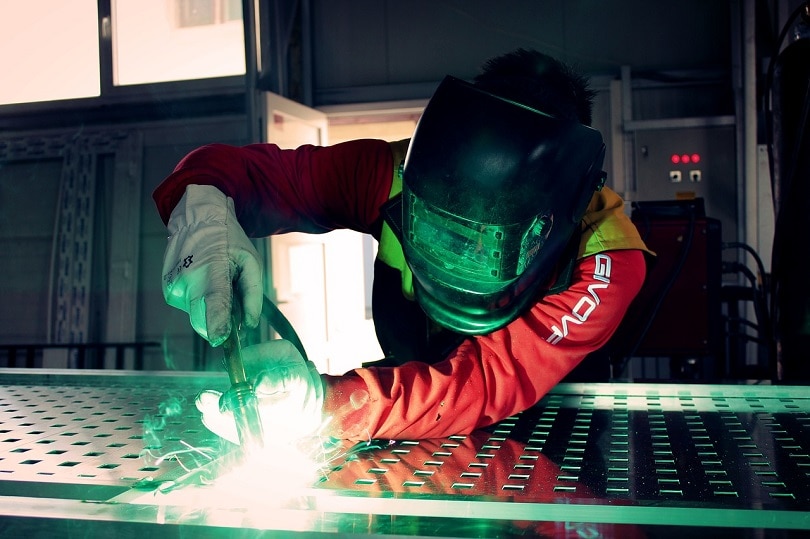Welding vs Bolting: Which Method Should You Use?
Last Updated on

Every trade has its tools, methods, and tricks. A framer fastens wood together with nails. A plumber may use a pipe joint compound. Metal fabricators use primarily welding and bolting to fasten together pieces of metal. For some welding may seem like more of a niche skill that can be difficult to learn without years of apprenticeship and training. Nothing could be further from the truth.
There is a wealth of resources that in a few hours can teach you how to make decent welds fit for your home project. Conversely, while bolting may seem like a simpler solution, it’s more multifaceted than it may seem. Let’s take a closer look at Welding vs Bolting.
Overview of Welding

There are a variety of welding processes. Shielded Metal Arc welding (commonly known as Stick or Arc welding), Gas Metal Arc Welding (GMAW or MIG), and Gas Tungsten Arc Welding (GTAW or TIG) are three of the most popular. Though there are differences in polarity, current, etc., nearly all processes use an electrical arc to melt the base material of one piece of metal to join it to another piece using added filler metal.
Advantages of Welding
By joining two pieces of metal together using additional filler metal, joints are made even stronger than with brazing and soldering, since with welding the base metal is melted and then fused with the filler metal. The bond between the two joint members will be strong for years to come.
Disadvantages of Welding
One of the downsides to welding is that depending on the application, it requires a certain skill level to function as it is supposed to. If the weld happens to be critical and integral to the structure of the workpiece, then it may require some significant practice and training to be able to weld it properly. The permanence of a weld is also a double-edged sword. If a piece of metal needs to be repaired but it is welded in place, removing the weld with an angle grinder or by carbon arc gouging can be costly and time-consuming.
Other Factors to Consider
Some other things to keep in mind when considering welding is the type and thickness of the material. For example, stainless steel is much more prone to heat distortion than mild steel. Depending on how much weld you have to put into the component, especially if it’s stainless and of a lighter gauge, you need to consider what the condition of the material will be after it’s welded.
Will the distortion negatively impact the component only in terms of cosmetics, or will it also impact its function?
The type of metal is also important. While stainless steel does not rust, if welded improperly and contaminated during the process it will most certainly rust given enough time. A similar thing happens with aluminum which oxidizes easily. While this may not be as much of a problem if your component will be used indoors, it’s something to consider if it will be exposed to the weather.
While welding can strengthen joints, if used disproportionately it will weaken the base material. A common problem is that a bad weld is made, so the welder will weld over it to rectify their mistake. But all this does is pile weld on top of weld, which will induce excessive stress into the material and weaken it, thereby shortening the life of your material. If you are not confident in your ability to weld, you may need to consider using bolts.
- Extremely strong bond
- Versatile applications and methods
- Risk of warping or distortion
- Need skill to perform
Overview of Bolting

In short, a bolt has machine threads that securely fasten inside a nut or other set of interlocking threads. There are literally hundreds of different types of bolts and fasteners. The applications are almost limitless. You can use nuts and washers on through-holes or drill and tap your own holes. There are temporary and permanent bolts. Thread locking compounds of varying strengths are also popular which can range from semi-permanent to fully permanent.
Advantages of Bolting
The versatility that comes with using bolts is probably the most attractive feature. The wide array of selection will allow you to find something that will fit your project. If you are looking to fasten two parts together securely but aren’t quite sure if it will be a permanent solution, bolts might be the way to go. Whereas with welding, a certain level of skill and training may be required to be effective, drilling holes and fastening bolts isn’t terribly complicated. Even tapping holes can be learned in an afternoon.
Disadvantages of Using Bolts
While bolts are extremely versatile, the majority of them are made to be replaceable. Bolts that are found in moving parts, such as safety gates, may be jostled loose by the movement over time and need to be snugged up again. Another downside is that while bolts are replaceable, sometimes doing so can be difficult. Bolts and screws sometimes have their threads stripped during installation. Certain types of bolts also tend to seize up and become difficult to remove. This happens especially with stainless steel. However, it can be mitigated with an anti-seize compound.
Other Factors to Consider
If you have thicker base material to fasten together, you are probably going to use some big bolts. This means you are going to need to drill equally large or larger holes. This calls for a drill press or magnetic drill with broaching tools which, unless you are already a fabricator, you probably don’t have just lying around the garage. It might be worth your while weighing out whether welding might be the easier option.
- Easy to install and remove
- Versatile
- Need to be replaced
- Risk of stripping
Which Type of Welding is Best?
There is no simple answer to this. As mentioned earlier, three of the most popular welding methods are Stick, MIG, and TIG. All of them have their strengths as well as their drawbacks.
Differences in Welding Processes
Stick welding requires the least amount of equipment with just the machine, leads, electrode holder, ground clamp, and electrodes for filler metal. Where simplicity is a positive for stick, the drawback is that it can take some time to learn. In comparison to MIG welding, it takes much longer since it has a lower filler metal deposition.
MIG welding, on the other hand, while it does require more equipment, including shielding gas and a wire feeder, can produce a lot more weld, and a lot quicker. The learning curve is not nearly as steep. It also has tremendous versatility. Some wires are designed to be used with shielding gas, which protects the weld from oxygen and other contaminants. Other wires have a flux inside (flux core) and can be used outside, even in high winds.
TIG Welding has an edge in precision, especially when working with small parts. On the other hand, TIG can prove difficult to learn, especially if you are a little shaky.
Difficulty vs. Price Point
Overall, MIG welding is probably going to be easiest for the enthusiast and DIYer. Building a rack for the back of a pickup truck, fixing a broken vice on the workbench, and fixing old exercise equipment are all projects perfect for MIG welding. Striking an arc comes at the pull of a trigger on the welding gun, which deposits the filler metal from the tip of the gun. That being said, if you are willing to take the time to learn Stick welding, the equipment can be on the less expensive end.
Fasteners as Complementary
Often times you are going to be repairing things around the house. But, if you are taking on a project at home where you are building something from scratch, you may want to weld some parts and bolt others. A rack for the back of a pickup truck may have larger components that are welded together, but at the final assembly are bolted. This allows you to disassemble when needed for tighter storage. As a rule, when fabricating it’s good to have a plan in advance. Once the rack is welded completely, there’s no going back without removing that weld.
Rivets, permanent fasteners, should also be considered. They can be useful when excessive weld will result in heat distortion or where welding could cause damage to other materials such as electrical connections, paint, etc. The connections routed from a power skid can be protected from outdoor weather by a stainless steel enclosure riveted to the backside of the skid.
Safety
Lastly, but certainly not least, safety is a factor when it comes to welding. Safe welding requires the right personal protective equipment. A welding helmet, welding gloves, leather work shoes/boots, and non-synthetic material clothing should be considered a minimum for PPE.
Welding emits harmful UV rays that can burn your eyes and skin. Welding also emits harmful carcinogenic fumes. Proper ventilation is of the utmost importance, especially if you are going to be welding for a longer period. Your lungs will thank you if you spring for a smoke eater or powered air-purifying respirator.
Final Thoughts: Welding vs Bolting
There is no ‘one size fits all’ solution to welding vs bolting. It depends on the scope of the project and how much you are willing to invest time and money into purchasing and learning equipment. Experimentation will help you find the right balance.
Featured image credit: Pixabay
